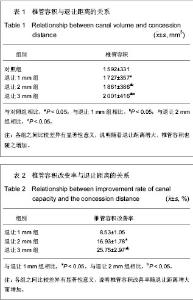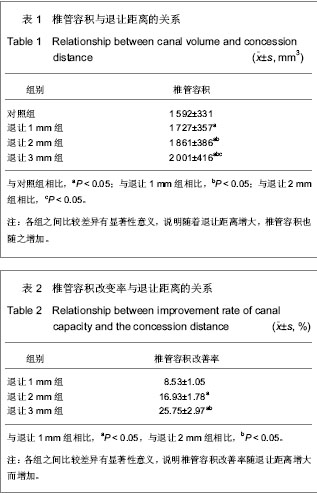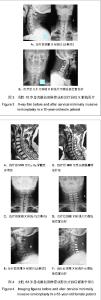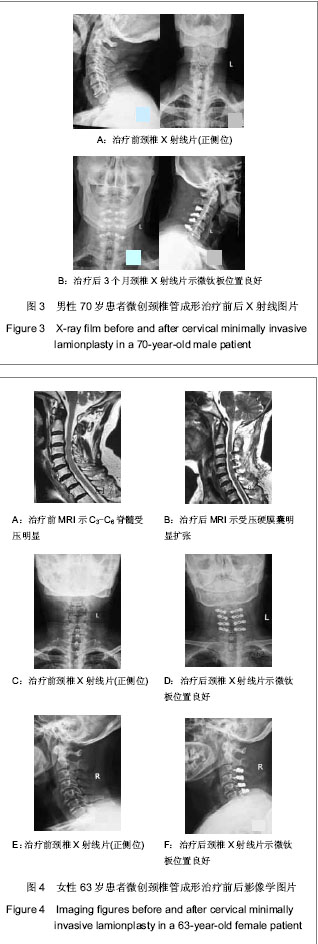Chinese Journal of Tissue Engineering Research
Previous Articles Next Articles
Spinal canal volume change and clinical significance of cervical minimally invasive lamionplasty with specimen simulation
Zhang Chun-lin, Zeng Zhao-feng, Tang Heng-tao, Yan Xu, Wang Chuang-jian
- Department of Orthopedics, the First Affiliated Hospital of Zhengzhou University, Zhengzhou 450052, Henan Province, China
-
Received:2013-02-04Revised:2013-03-05Online:2013-06-25Published:2013-06-25
CLC Number:
Cite this article
Zhang Chun-lin, Zeng Zhao-feng, Tang Heng-tao, Yan Xu, Wang Chuang-jian. Spinal canal volume change and clinical significance of cervical minimally invasive lamionplasty with specimen simulation[J]. Chinese Journal of Tissue Engineering Research, doi: 10.3969/j.issn.2095-4344.2013.26.014.
share this article
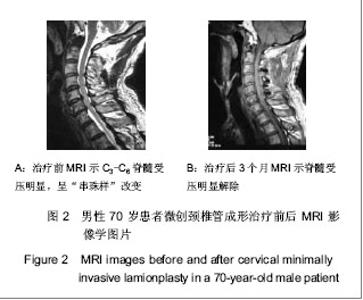
由表1,2可见,椎管容积的扩大程度随棘突椎板后退距离增大而增加;退让2 mm组与退让1 mm组比较,差异有显著性意义(P < 0.05),退让3 mm组与退让2 mm组比较,差异有显著性意义(P < 0.05),退让3 mm组与退让1 mm组相比,差异有显著性意义(P < 0.05)。 2.2 临床观察结果 2.2.1 参与者数量分析 36例患者均进入结果分析,无一例死亡。 2.2.2 手术时间、出血量 36例患者手术时间平均为75 min(50-105 min),出血量平均为380 mL(300- 450 mL)。 2.2.3 JOA评分 随访3个月-1年,平均8个月,治疗前JOA评分为7.97±1.73,末次随访时JOA评分为13.14±1.74,差异有显著性意义(P < 0.05),改善率(58.55±13.71)%。 2.2.4 疗效 优9例,良21例,一般6例,优良率为83.3%。 2.2.5 并发症 36例患者治疗后3-6个月完全恢复日常劳动能力,1例治疗前症状较重者(下肢不全瘫)恢复可,1例出现轻微轴性症状,未出现节段性颈神经根麻痹。未见微钛钉及钛板松动、断裂。 2.2.6 典型病例分析 典型病例1:患者男,70岁,主诉左上肢无力10个月余,双下肢无力2个月余。治疗前影像学显示C3-C6脊髓受压明显,呈“串珠样”改变,并椎管狭窄,择期在神经阻滞麻醉下行C3-C6微创颈椎管成形,影像学图片见图2,3。"
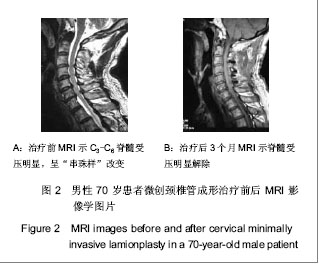
| [1] Hirabayashi K, Watanabe K, Wakano K,et al. Expansive open-door laminoplasty for cervical spinal stenotic myelopathy. Spine (Phila Pa 1976). 1983;8(7):693-699.[2] Wang MY, Shah S, Green BA. Clinical outcomes following cervical laminoplasty for 204 patients with cervical spondylotic myelopathy.Surg Neurol. 2004;62(6):487-492.[3] Hale JJ, Gruson KI, Spivak JM. Laminoplasty: a review of its role in compressive cervical myelopathy.Spine J. 2006;6 (6 Suppl): 289S-298S.[4] Kaner T, Sasani M, Okteno?lu T,et al. Clinical outcomes following cervical laminoplasty for 19 patients with cervical spondylotic myelopathy.Turk Neurosurg. 2009;19(2):121-126.[5] Hardman J, Graf O, Kouloumberis PE,et al. Clinical and functional outcomes of laminoplasty and laminectomy. Neurol Res. 2010;32(4):416-420.[6] Chiba K, Ogawa Y, Ishii K,et al. Long-term results of expansive open-door laminoplasty for cervical myelopathy--average 14-year follow-up study.Spine (Phila Pa 1976). 2006;31(26):2998-3005.[7] Matsumoto M, Chiba K, Toyama Y. Surgical treatment of ossification of the posterior longitudinal ligament and its outcomes: posterior surgery by laminoplasty.Spine (Phila Pa 1976). 2012;37(5):E303-308.[8] Sakaura H, Hosono N, Mukai Y,et al. Long-term outcome of laminoplasty for cervical myelopathy due to disc herniation: a comparative study of laminoplasty and anterior spinal fusion.Spine (Phila Pa 1976). 2005;30(7):756-759.[9] Nakamura K,Toyama Y, Hoshino Y. Cervical pain after laminoplasty .In:Cervical Laminoplasty.New York: Springer, 2003:169-174.[10] Shiraishi T, Fukuda K, Yato Y,et al. Results of skip laminectomy-minimum 2-year follow-up study compared with open-door laminoplasty.Spine (Phila Pa 1976). 2003;28(24): 2667-2672.[11] Luk KD, Kamath V, Avadhani A,et al.Cervical laminoplasty. Eur Spine J. 2010;19(2):347-348.[12] Kawaguchi Y, Kanamori M, Ishihara H,et al. Minimum 10-year followup after en bloc cervical laminoplasty.Clin Orthop Relat Res. 2003;(411):129-139.[13] Yoshida M, Tamaki T, Kawakami M,et al. Does reconstruction of posterior ligamentous complex with extensor musculature decrease axial symptoms after cervical laminoplasty. Spine (Phila Pa 1976). 2002;27(13):1414-1418.[14] Takeshita K, Peterson ET, Bylski-Austrow D,et al. The nuchal ligament restrains cervical spine flexion.Spine (Phila Pa 1976). 2004;29(18):E388-393.[15] Liu J, Ebraheim NA, Sanford CG Jr,et al. Preservation of the spinous process-ligament-muscle complex to prevent kyphotic deformity following laminoplasty.Spine J. 2007;7(2): 159-164. [16] Stemper BD, Marawar SV, Yoganandan N,et al.Quantitative anatomy of subaxial cervical lateral mass: an analysis of safe screw lengths for Roy-Camille and magerl techniques.Spine (Phila Pa 1976). 2008;33(8):893-897.[17] Xin XH,Wu Q,Tang HJ,et al. Zhongguo Zuzhi Gongcheng Yanjiu yu Linchuang Kangfu. 2009;13(4):662-666.席新华,吴强,唐华军,等.成人下颈椎椎体与关节突关节倾角的X射线测量数据[J].中国组织工程研究与临床康复,2009,13(4): 662-666.[18] Chu G,Bai JP,Xilin•Baoleri. Zhongguo Zuzhi Gongcheng Yanjiu yu Linchuang Kangfu. 2009;13(13):2460-2464.楚戈,白靖平,锡林•宝勒日,等.无X射线引导下颈椎侧块钉置入技术的应用[J].中国组织工程研究与临床康复,2009,13(13): 2460-2464.[19] Barrey C, Mertens P, Rumelhart C,et al. Biomechanical evaluation of cervical lateral mass fixation: a comparison of the Roy-Camille and Magerl screw techniques.J Neurosurg. 2004;100(3 Suppl Spine):268-276.[20] Chiewvit P, Tritrakarn SO, Phawjinda A,et al. Predictive value of magnetic resonance imaging in cervical spondylotic myelopathy in prognostic surgical outcome.J Med Assoc Thai. 2011;94(3):346-354.[21] Cho WS, Chung CK, Jahng TA,et al. Post-laminectomy kyphosis in patients with cervical ossification of the posterior longitudinal ligament : does it cause neurological deterioration. J Korean Neurosurg Soc. 2008;43(6):259-264.[22] Greiner-Perth R, Elsaghir H, Böhm H,et al. The incidence of C5-C6 radiculopathy as a complication of extensive cervical decompression: own results and review of literature. Neurosurg Rev. 2005;28(2):137-142.[23] Nassr A, Eck JC, Ponnappan RK,et al.The incidence of C5 palsy after multilevel cervical decompression procedures: a review of 750 consecutive cases.Spine (Phila Pa 1976). 2012;37(3):174-178.[24] Sakaura H, Hosono N, Mukai Y,et al. C5 palsy after decompression surgery for cervical myelopathy: review of the literature.Spine (Phila Pa 1976). 2003;28(21):2447-2451.[25] Hashimoto M, Mochizuki M, Aiba A,et al. C5 palsy following anterior decompression and spinal fusion for cervical degenerative diseases. Eur Spine J. 2010;19(10):1702-1710.[26] Kong Q, Zhang L, Liu L,et al. Effect of the decompressive extent on the magnitude of the spinal cord shift after expansive open-door laminoplasty.Spine (Phila Pa 1976). 2011;36(13):1030-1036.[27] Minoda Y, Nakamura H, Konishi S,et al. Palsy of the C5 nerve root after midsagittal-splitting laminoplasty of the cervical spine.Spine (Phila Pa 1976). 2003;28(11):1123-1127.[28] Imagama S, Matsuyama Y, Yukawa Y,et al. C5 palsy after cervical laminoplasty: a multicentre study.J Bone Joint Surg Br. 2010;92(3):393-400.[29] Zhang W,Li PF,Yang DL,et al. Zhongguo Jiaoxing Waike Zazhi. 2011;19(1):11-14.张为,李鹏飞,杨大龙,等.颈椎后路减压术后脊髓后移的临床意义[J].中国矫形外科杂志,2011,19(1):11-14.[30] Iizuka H, Nakajima T, Iizuka Y,et al. Cervical malalignment after laminoplasty: relationship to deep extensor musculature of the cervical spine and neurological outcome.J Neurosurg Spine. 2007;7(6):610-614.[31] Rhee JM, Register B, Hamasaki T,et al. Plate-only open door laminoplasty maintains stable spinal canal expansion with high rates of hinge union and no plate failures.Spine (Phila Pa 1976). 2011;36(1):9-14.[32] Zhang CL,Jiang Y,Zhong CN,et al. Zhengzhou Daxue Xuebao: Yixueban. 2007;43(2):584-586.张春霖,姜岩,钟楚楠,等.脊髓型颈椎病钛板双向固定颈椎管扩大成形术治疗58例体会[J].郑州大学学报:医学版,2007,43(2): 584-586.[33] Takeuchi K, Yokoyama T, Aburakawa S,et al. Axial symptoms after cervical laminoplasty with C3 laminectomy compared with conventional C3-C7 laminoplasty: a modified laminoplasty preserving the semispinalis cervicis inserted into axis.Spine (Phila Pa 1976). 2005;30(22):2544-2549.[34] Hosono N, Sakaura H, Mukai Y,et al. C3-6 laminoplasty takes over C3-7 laminoplasty with significantly lower incidence of axial neck pain.Eur Spine J. 2006;15(9):1375-1379.[35] Fujibayashi S, Neo M, Yoshida M,et al. Neck muscle strength before and after cervical laminoplasty: relation to axial symptoms.J Spinal Disord Tech. 2010;23(3):197-202.[36] Takeshita K, Seichi A, Akune T,et al. Can laminoplasty maintain the cervical alignment even when the C2 lamina is contained. Spine (Phila Pa 1976). 2005;30(11):1294-1298.[37] Iizuka H, Nakajima T, Iizuka Y,et al.Cervical malalignment after laminoplasty: relationship to deep extensor musculature of the cervical spine and neurological outcome.J Neurosurg Spine. 2007;7(6):610-614.[38] Kotani Y, Abumi K, Ito M,et al. Minimum 2-year outcome of cervical laminoplasty with deep extensor muscle-preserving approach: impact on cervical spine function and quality of life.Eur Spine J. 2009;18(5):663-671.[39] Dong FL,Shen CL,Jiang S,et al. Zhongguo Jiaoxing Waike Zazhi. 2008;16(9):682-686,701.董福龙,申才良,江曙,等.颈椎椎管容积的动态CT测量及其临床意义[J].中国矫形外科杂志,2008,16(9):682-686,701. |
| [1] | Zhang Tongtong, Wang Zhonghua, Wen Jie, Song Yuxin, Liu Lin. Application of three-dimensional printing model in surgical resection and reconstruction of cervical tumor [J]. Chinese Journal of Tissue Engineering Research, 2021, 25(9): 1335-1339. |
| [2] | Liu Zhengpeng, Wang Yahui, Zhang Yilong, Ming Ying, Sun Zhijie, Sun He. Application of 3D printed interbody fusion cage for cervical spondylosis of spinal cord type: half-year follow-up of recovery of cervical curvature and intervertebral height [J]. Chinese Journal of Tissue Engineering Research, 2021, 25(6): 849-853. |
| [3] | Luo Xuanxiang, Jing Li, Pan Bin, Feng Hu. Effect of mecobalamine combined with mouse nerve growth factor on nerve function recovery after cervical spondylotic myelopathy surgery [J]. Chinese Journal of Tissue Engineering Research, 2021, 25(5): 719-722. |
| [4] | Lin Dongxin, Huang Xuecheng, Qin Qingguang, Yang Yang, Deng Yuping, Tan Jinchuan, Wang Mian, Su Weiwei, Huang Tao, Huang Wenhua. Comparison of motion range of cervical spine after two cervical manipulations based on motion capture technique [J]. Chinese Journal of Tissue Engineering Research, 2021, 25(21): 3281-3285. |
| [5] | Wu Yanyu, Zhang Chunlin, Shao Chenglong, Yan Xu, Liu Xiaokang, Wang Yongkui, Li Dongzhe. Quantitative measurement of resorption of cervical herniated disc after cervical microendoscopic laminoplasty by two-dimensional distance method and three-dimensional volume method [J]. Chinese Journal of Tissue Engineering Research, 2021, 25(21): 3390-3394. |
| [6] | Zhao Shuangdan, Zheng Jiahua, Qi Wenbo, Huang Xianghua. Role and mechanism of exosomes derived from mesenchymal stem cells in reproductive system diseases [J]. Chinese Journal of Tissue Engineering Research, 2021, 25(19): 3097-3102. |
| [7] | Ren Bingkai, Zheng Yibin, Huang Leiwen, Wu Fanhui, Yang Dong . Value of respiratory tract management and fiberoptic bronchoscopy in traumatic cervical spinal cord injury [J]. Chinese Journal of Tissue Engineering Research, 2021, 25(18): 2902-2907. |
| [8] | Qu Xingyue, Zhou Jianqiang, Xu Xuebin, Zhang Shaojie, Li Zhijun, Wang Xing. Finite element analysis of screw-bone anti-pullout in four models of anterior lower cervical fixation in children [J]. Chinese Journal of Tissue Engineering Research, 2021, 25(18): 2816-2821. |
| [9] | Ruan Hanjiang, Jin Genyang, Li Xinwu, Yao Jian, Wu Peng, Zhang Yin, Zhang Shuai, Xiao Jun . Biomechanical properties of three types of posterior single-segment fixation for type II Hangman’s fracture [J]. Chinese Journal of Tissue Engineering Research, 2021, 25(15): 2309-2314. |
| [10] | Chen Jiang, Li Jinyu, Zheng Chenying, Bai Chunxiao, Zhang Fan, Liu Chuyin, Zhao Xueqian, Yuan Qiaomei, Di Xueshi, Kang Shengqian, Jia Yusong . Changes in sagittal parameters of cervical spine after double-segment artificial cervical disc replacement and anterior cervical discectomy and fusion [J]. Chinese Journal of Tissue Engineering Research, 2021, 25(15): 2341-2346. |
| [11] | Ma Long, Tan Xiaoxin, Sun Guoshao. A 5-year follow-up on sagittal alignment and radiological outcomes of consecutive three-level anterior cervical discectomy and fusion and hybrid surgery [J]. Chinese Journal of Tissue Engineering Research, 2021, 25(12): 1879-1885. |
| [12] | Yu Bin, Peng Yinxiao, Xue Li, Qin Hui, Liang Yijian. Comparison between anterior cervical discectomy and fusion using Zero-P and traditional anterior cervical plate plus cage for treating two-level cervical spondylosis [J]. Chinese Journal of Tissue Engineering Research, 2020, 24(9): 1342-1347. |
| [13] | Luo Haitao, Cheng Zujue, Lü Shigang, Xiao Juexian, He Wei, Huang Kai, Fan Yanghua, Zhu Xingen. Microscope-assisted versus traditional anterior cervical approach for cervical spondylopathy: a meta-analysis [J]. Chinese Journal of Tissue Engineering Research, 2020, 24(9): 1464-1470. |
| [14] |
Liu Lu, Wang Xing, Kang Xiaoyan, Li Guihua, Li Xiaohe, Gao Shang, Cai Yongqiang, Zhang Shaojie, Li Zhijun.
Digital three-dimensional morphology of cervical joint facet in 7-12-year-old children |
| [15] | Cao Bin, Zuo Yuqiang, Li Cunrui, Kang Weifeng, Yu Haiquan, Su Jingyang. Correlation of parameters of lordosis type cervical spine saggital plane in asymptomatic adults [J]. Chinese Journal of Tissue Engineering Research, 2020, 24(6): 898-902. |
| Viewed | ||||||
|
Full text |
|
|||||
|
Abstract |
|
|||||
